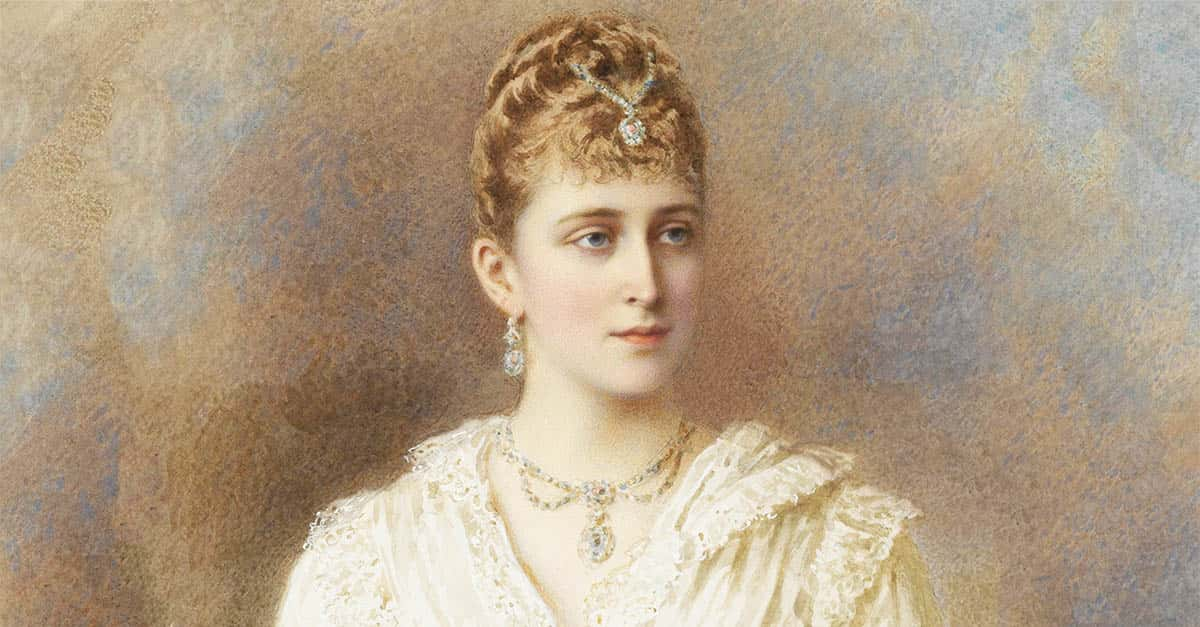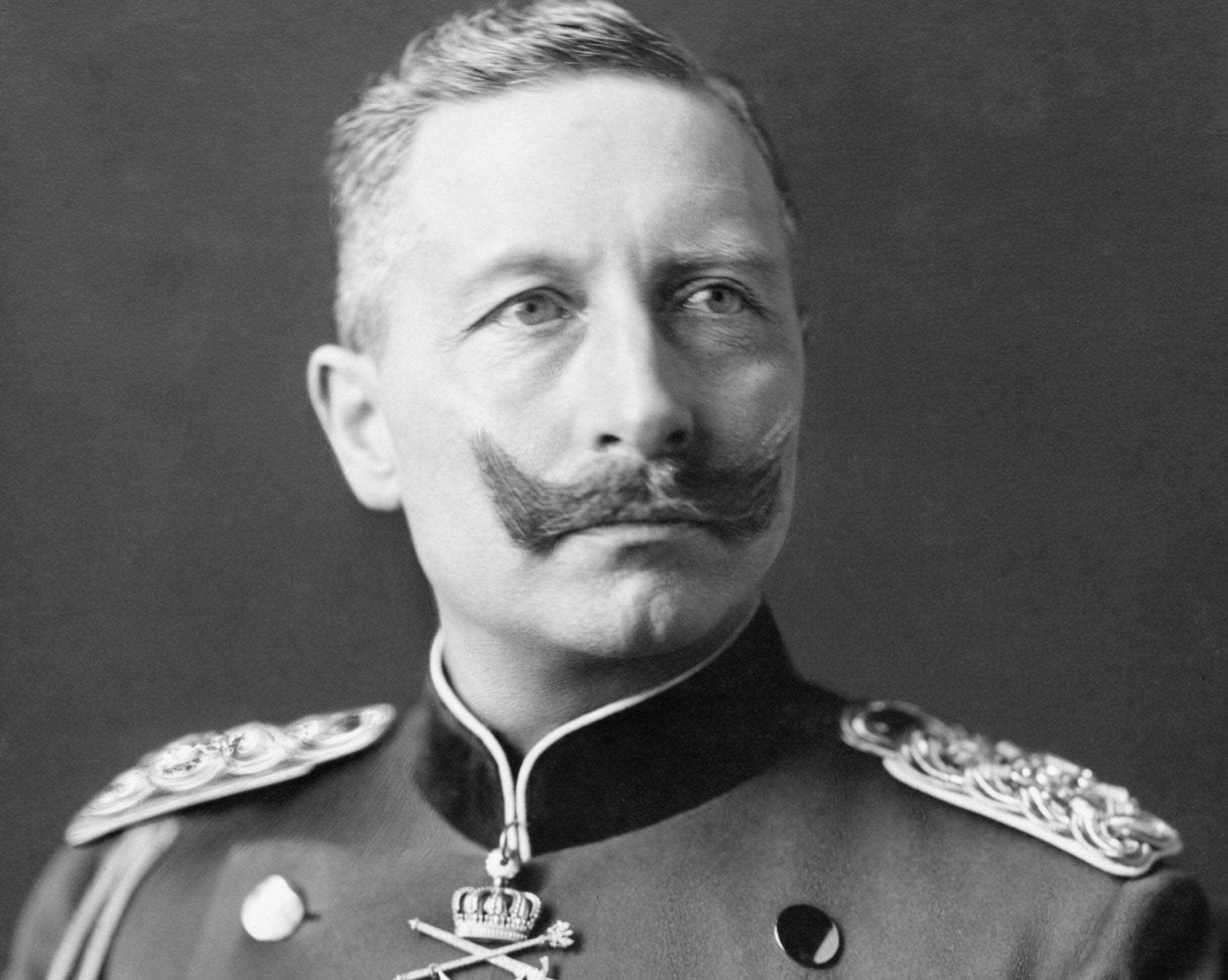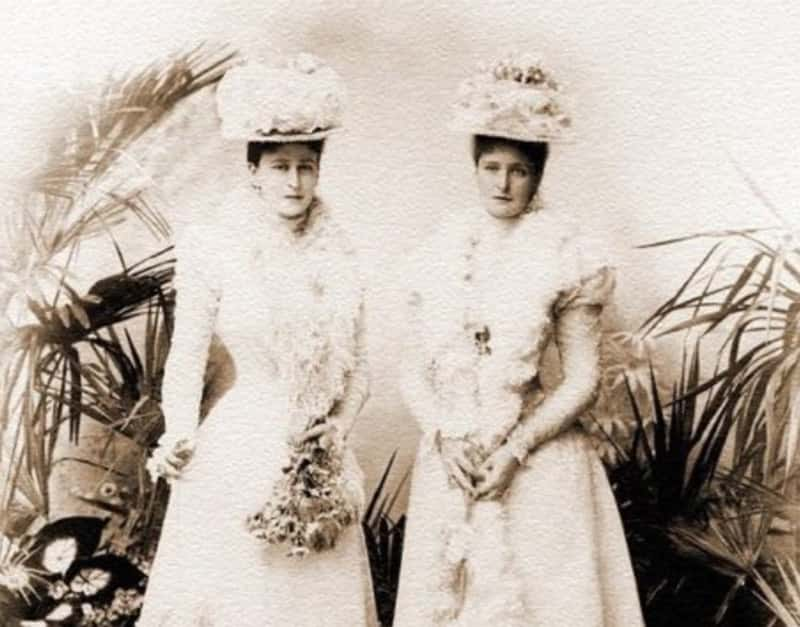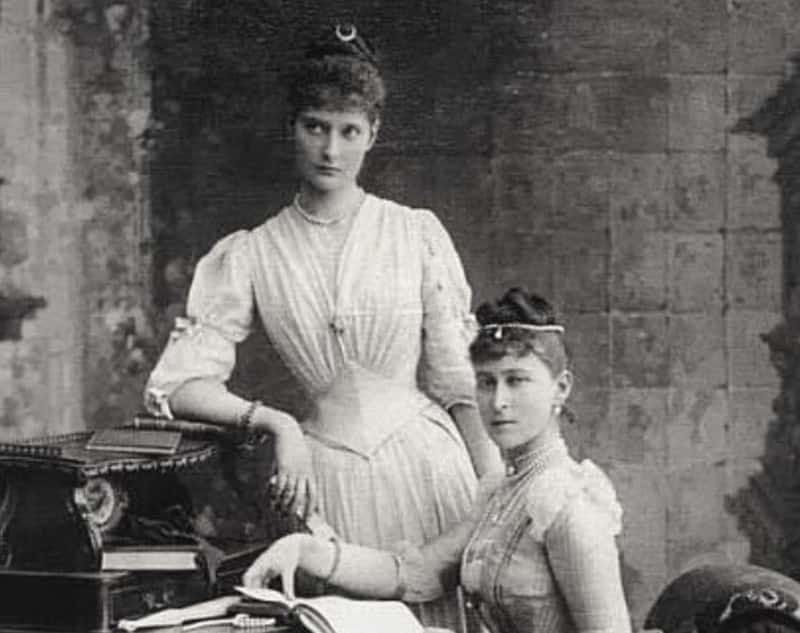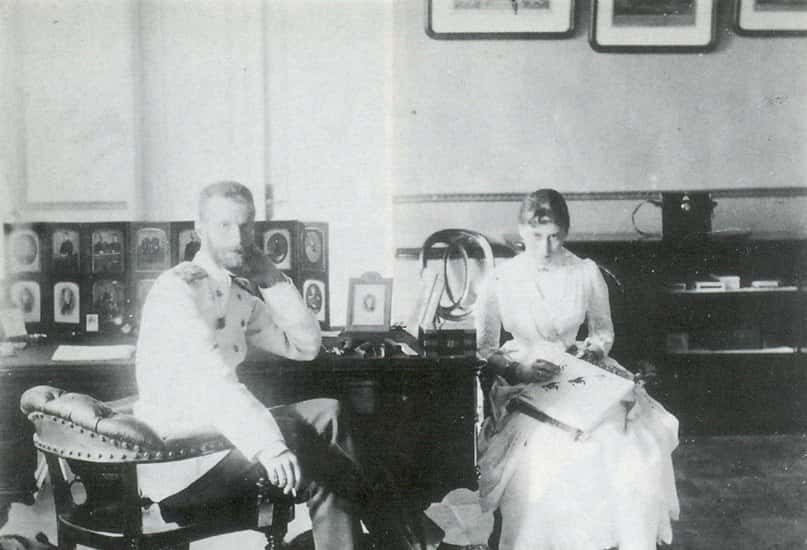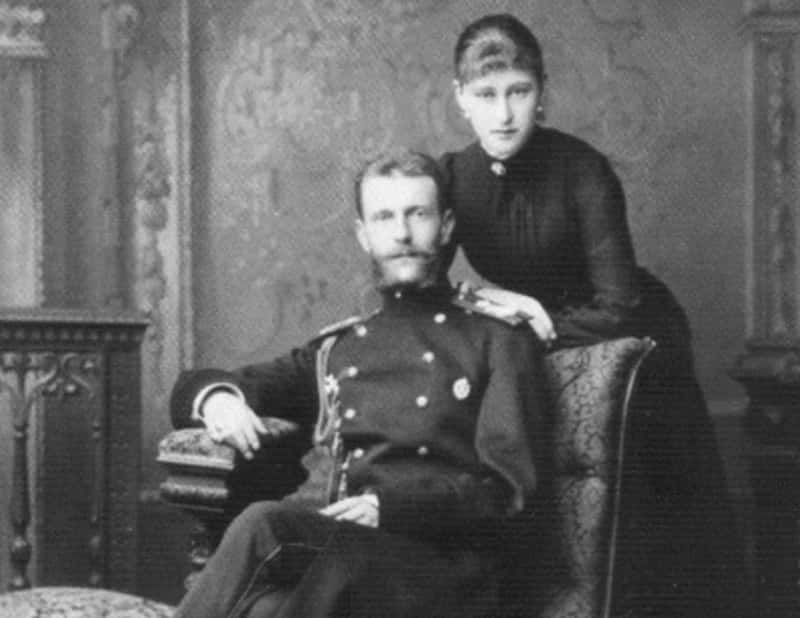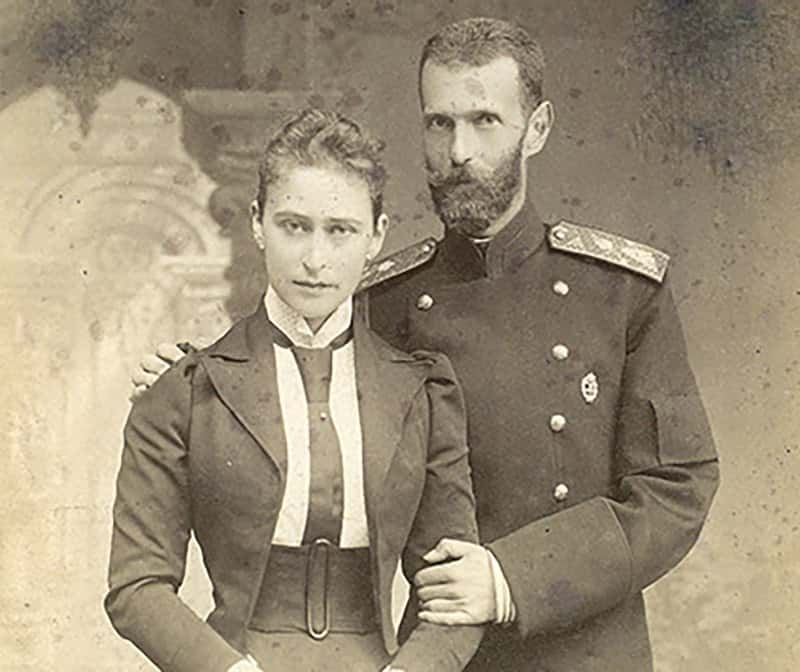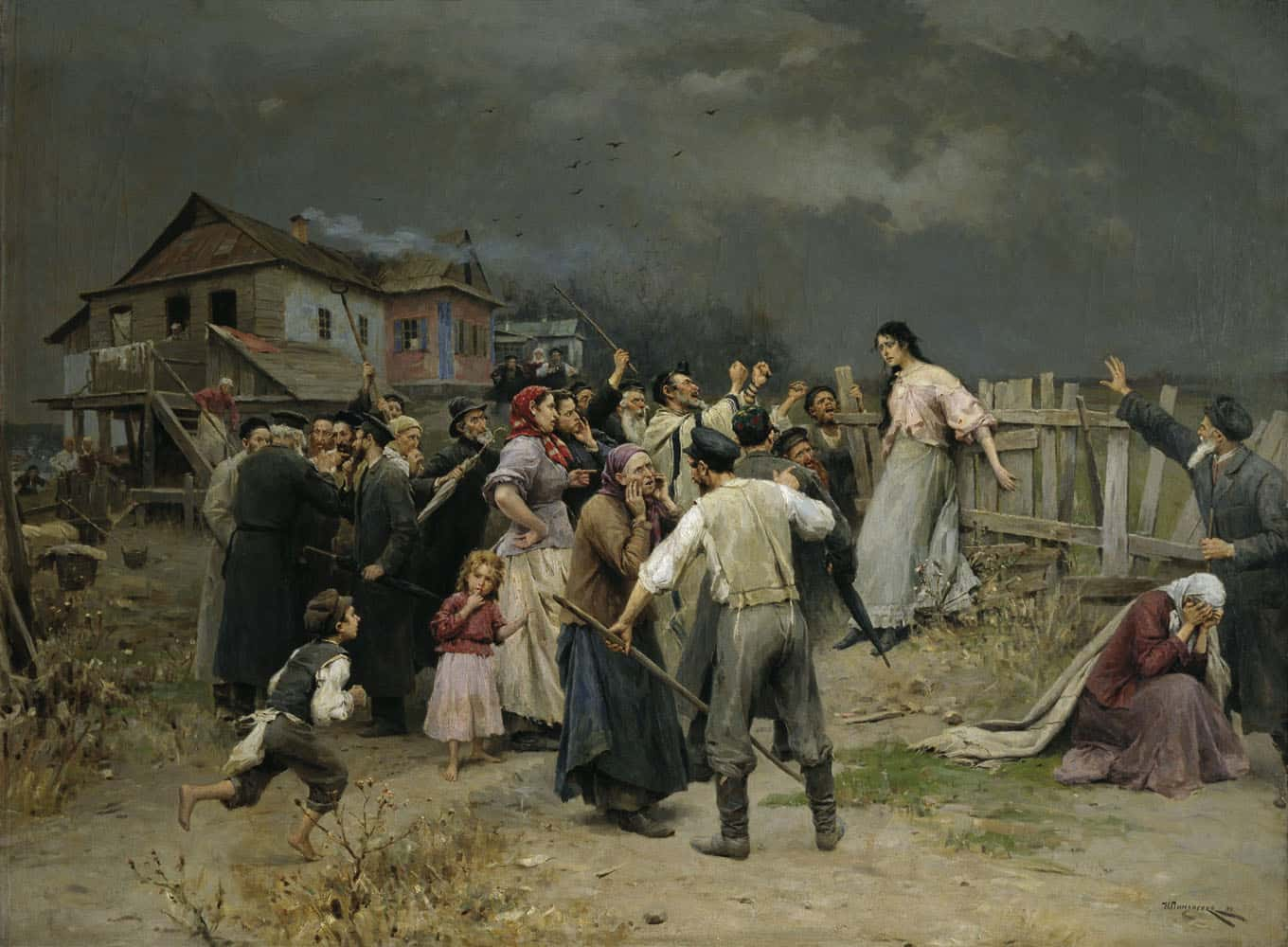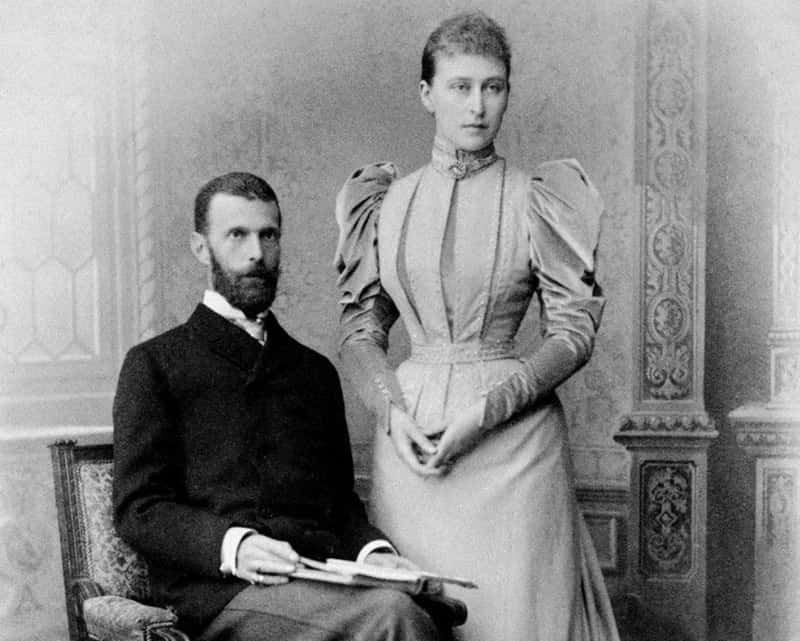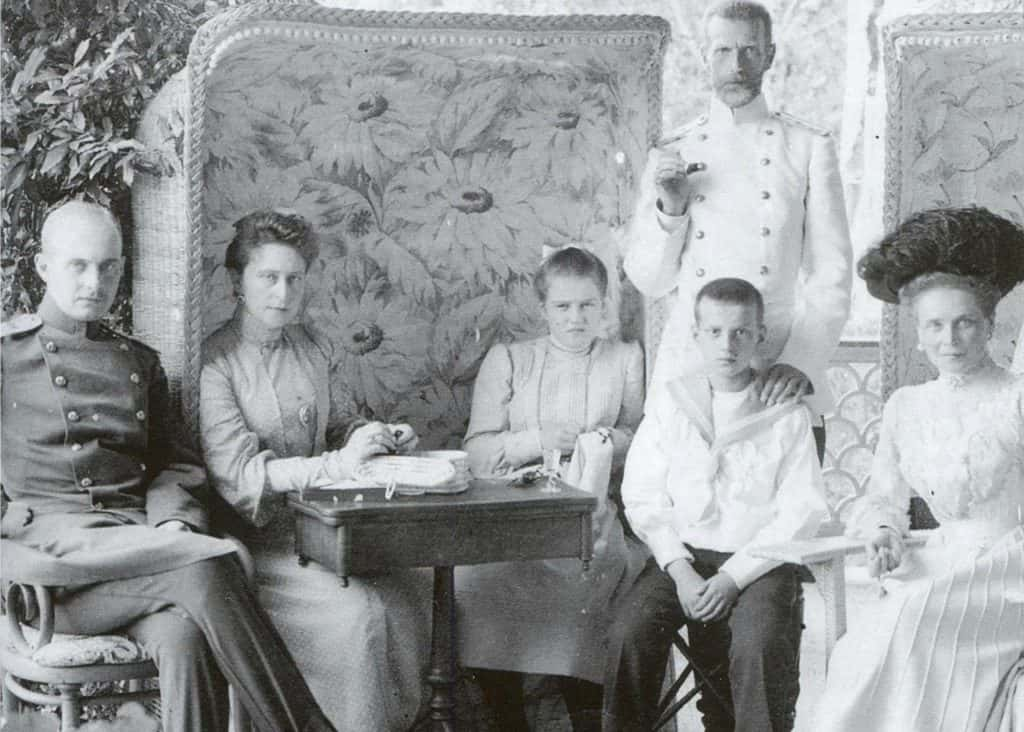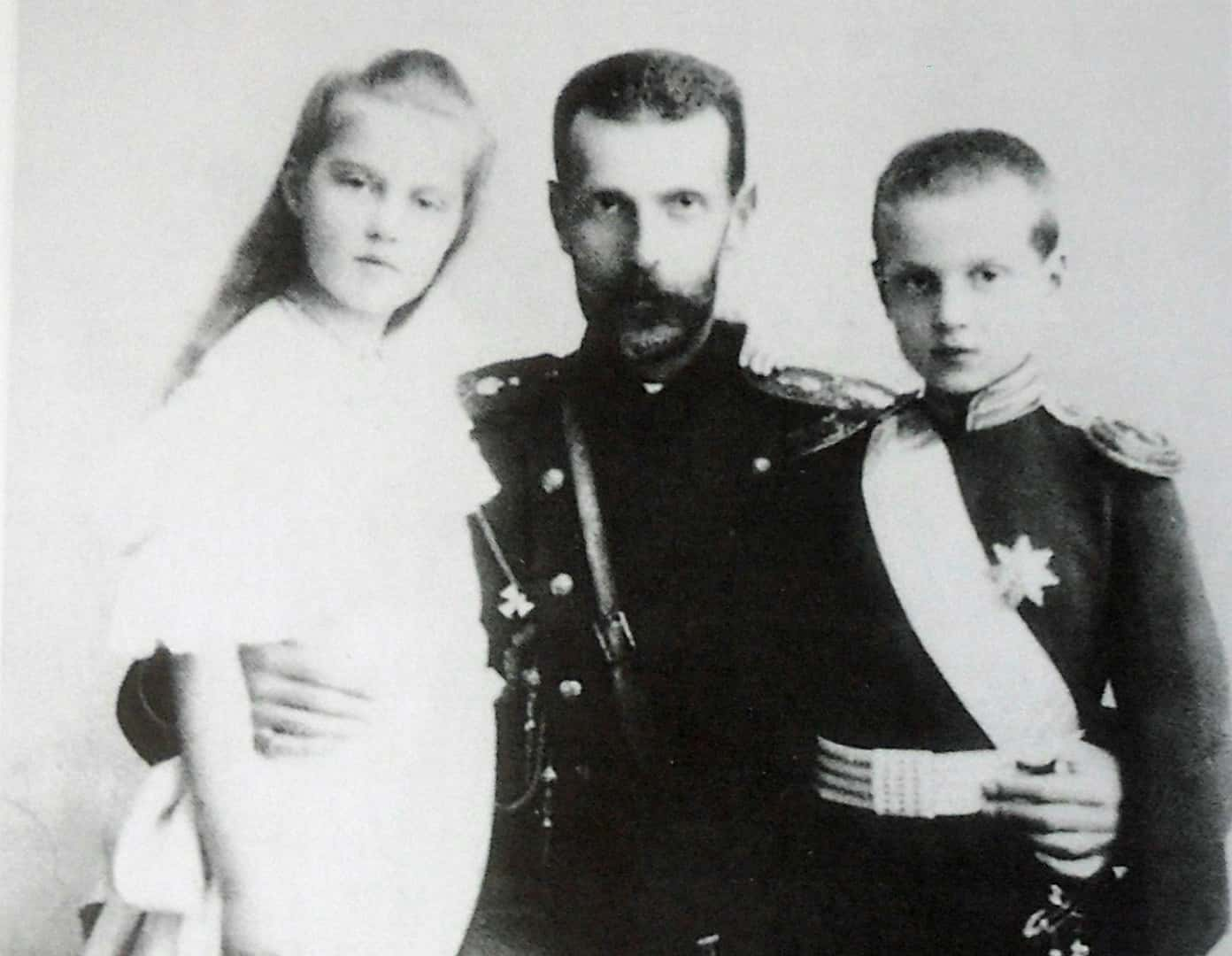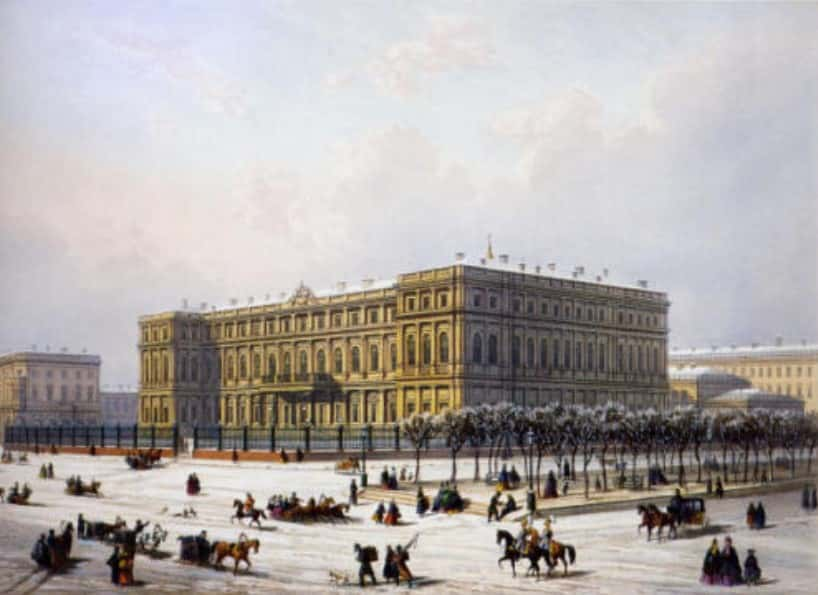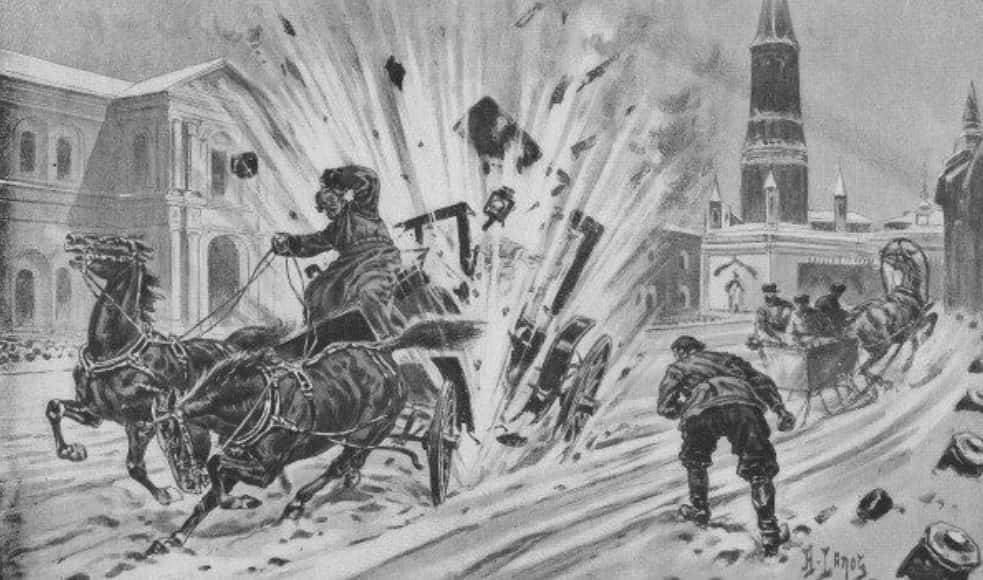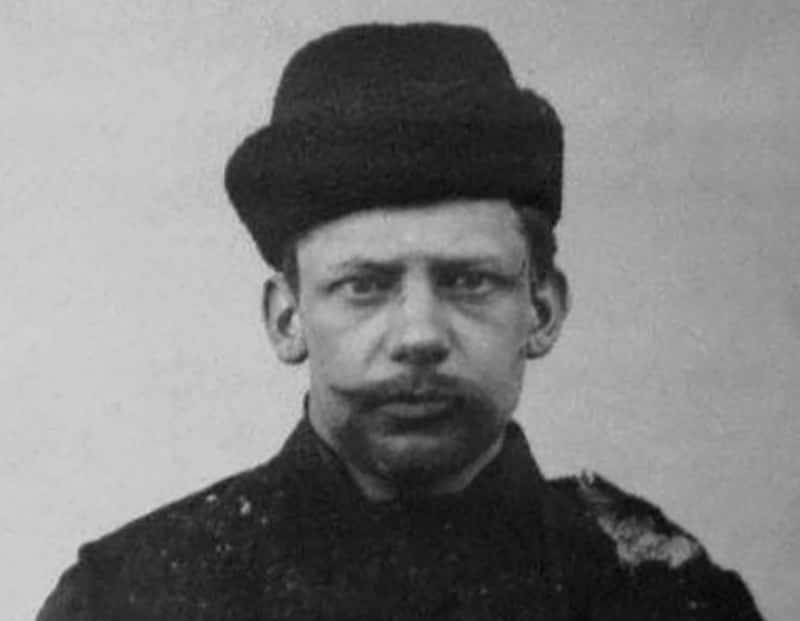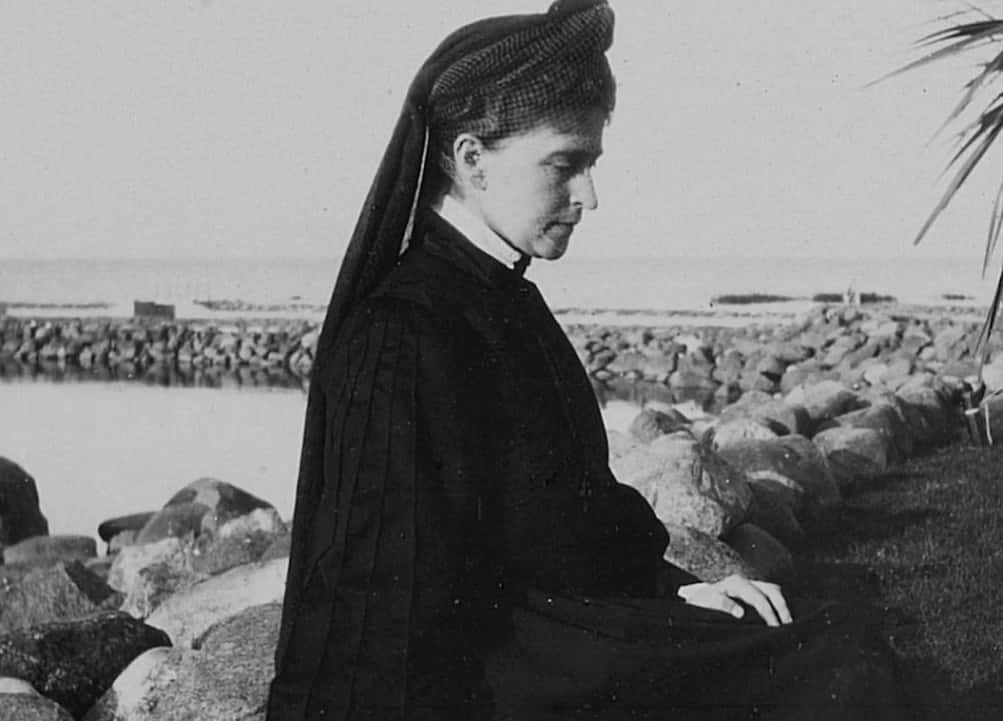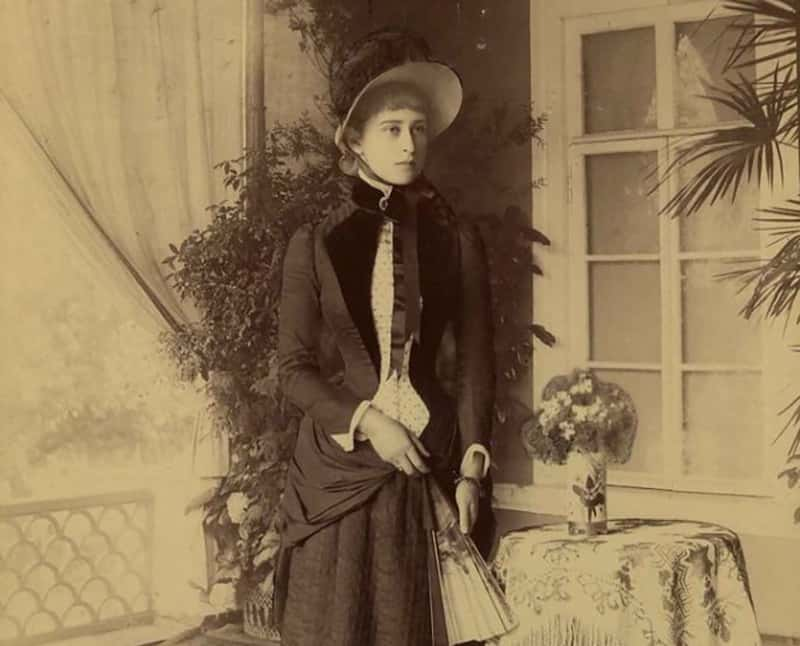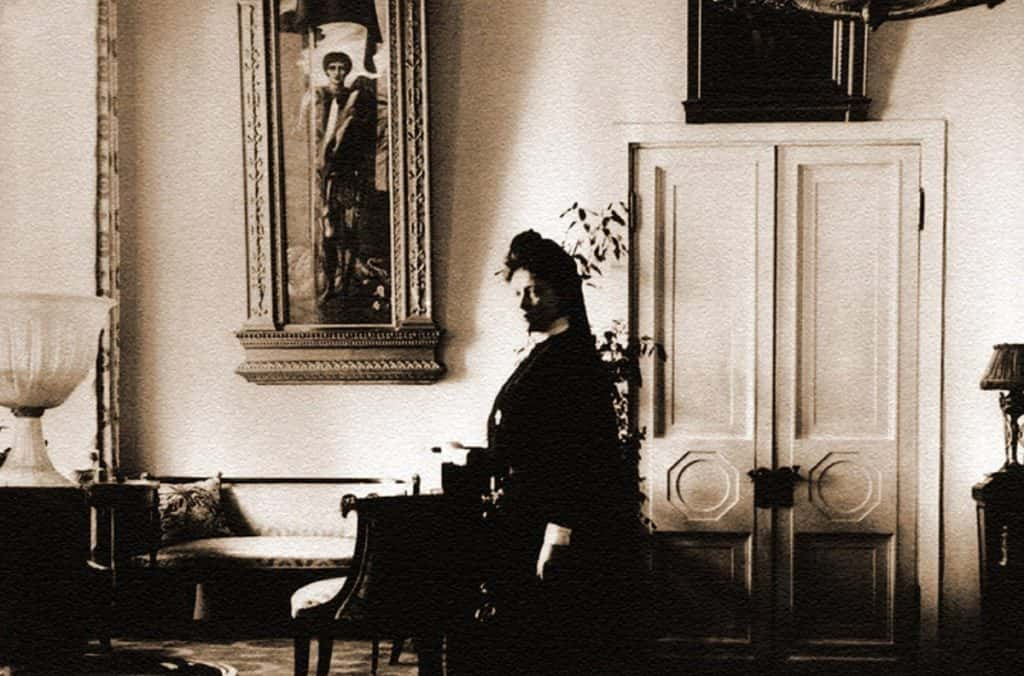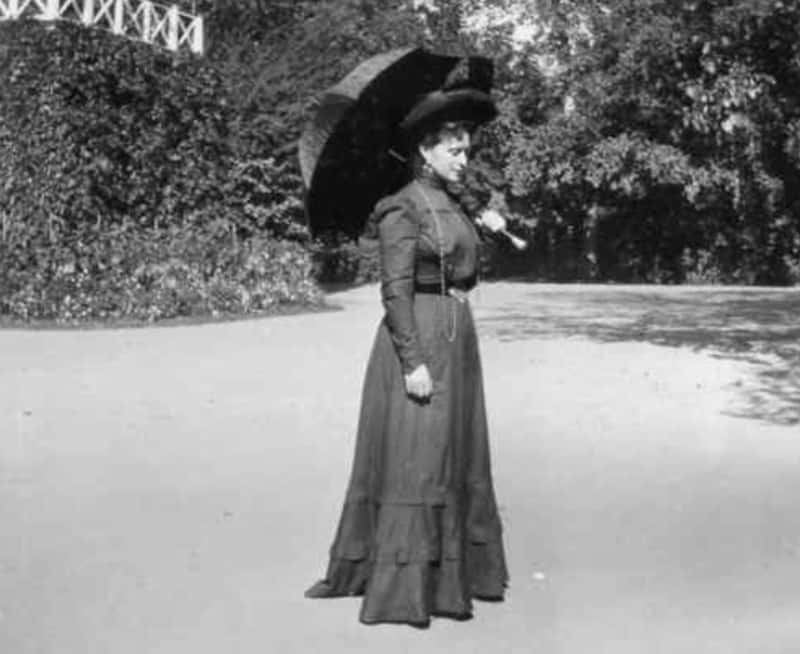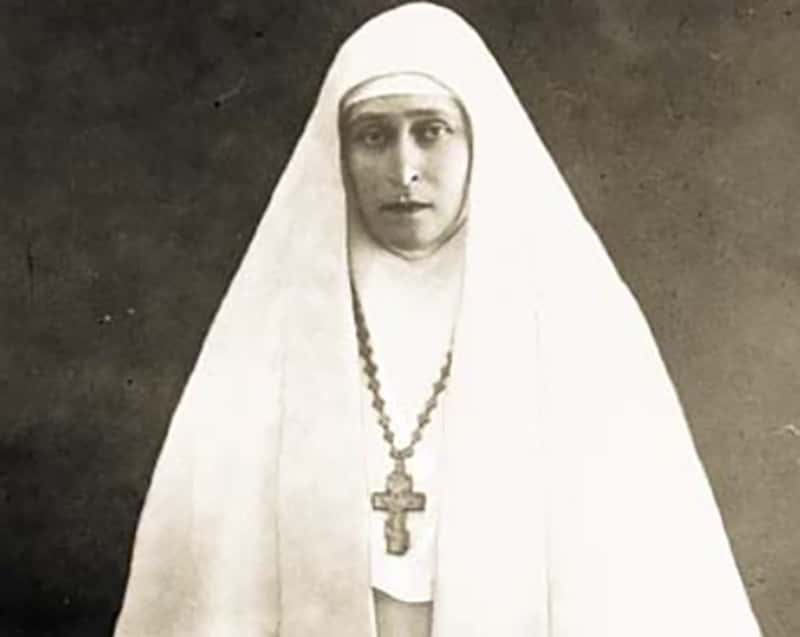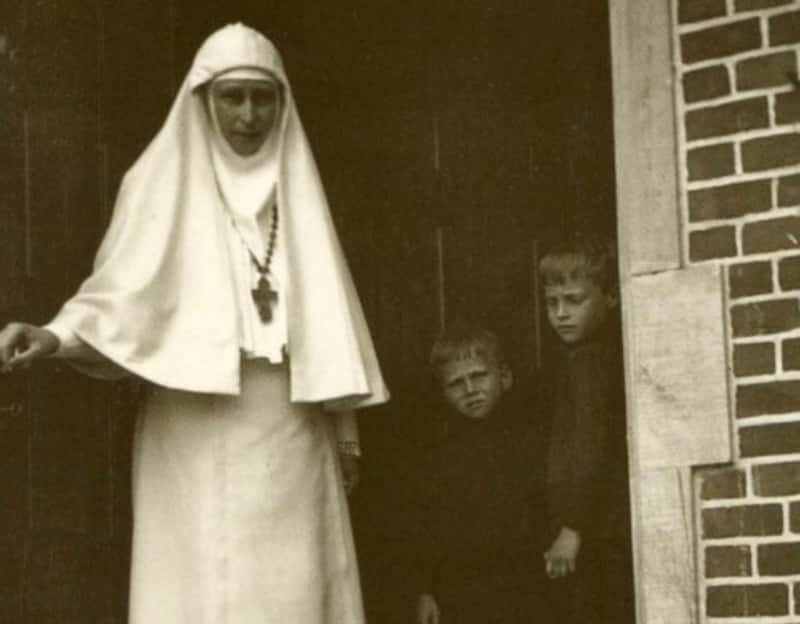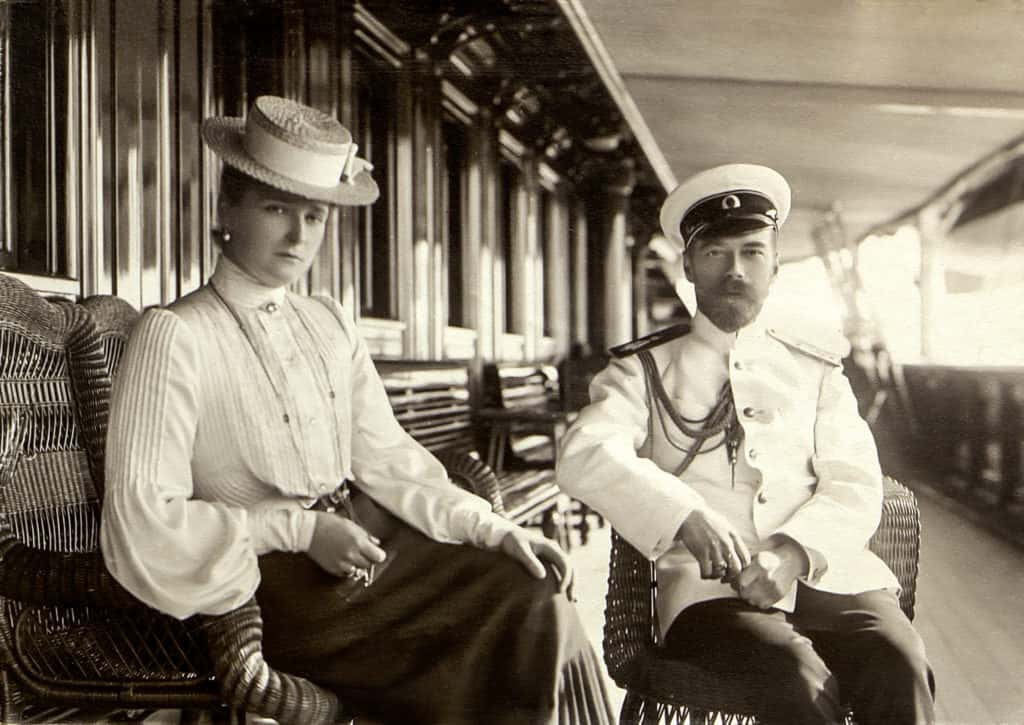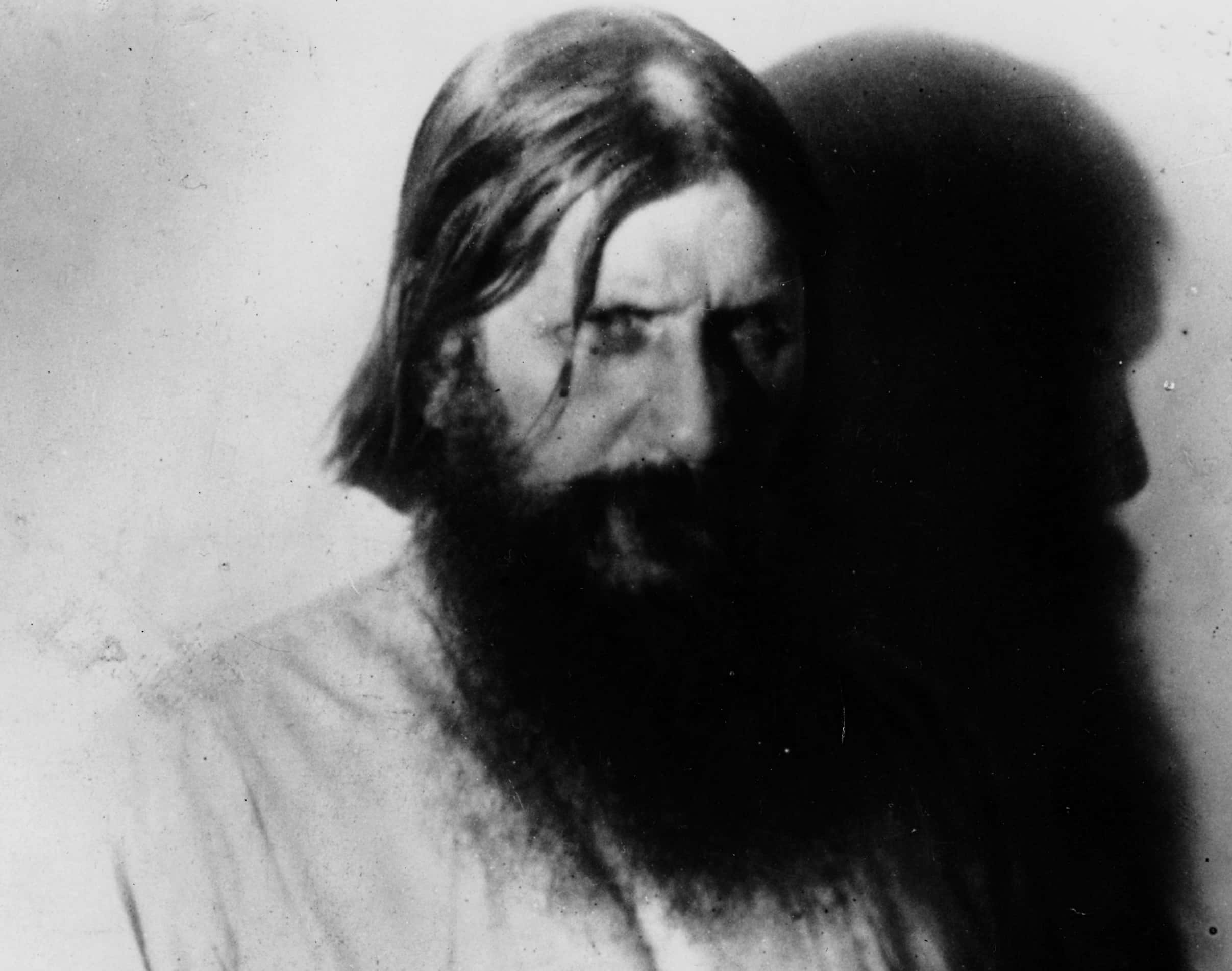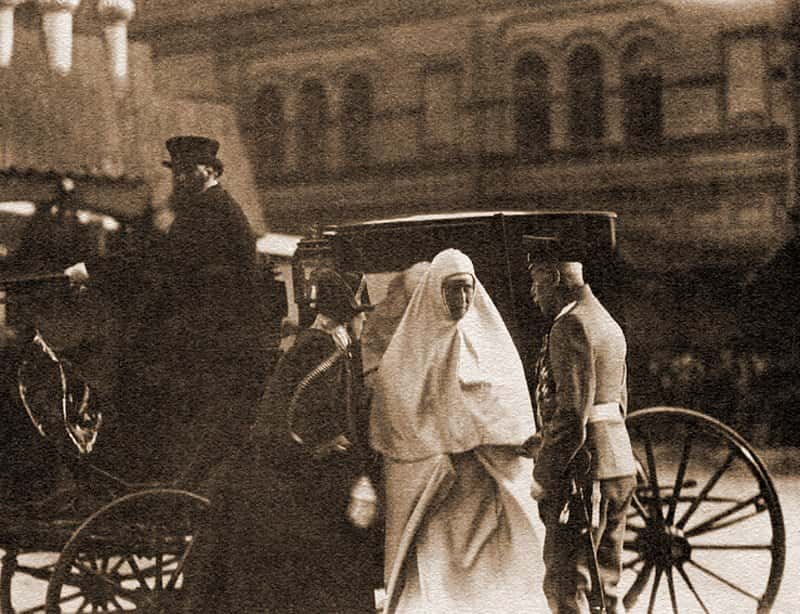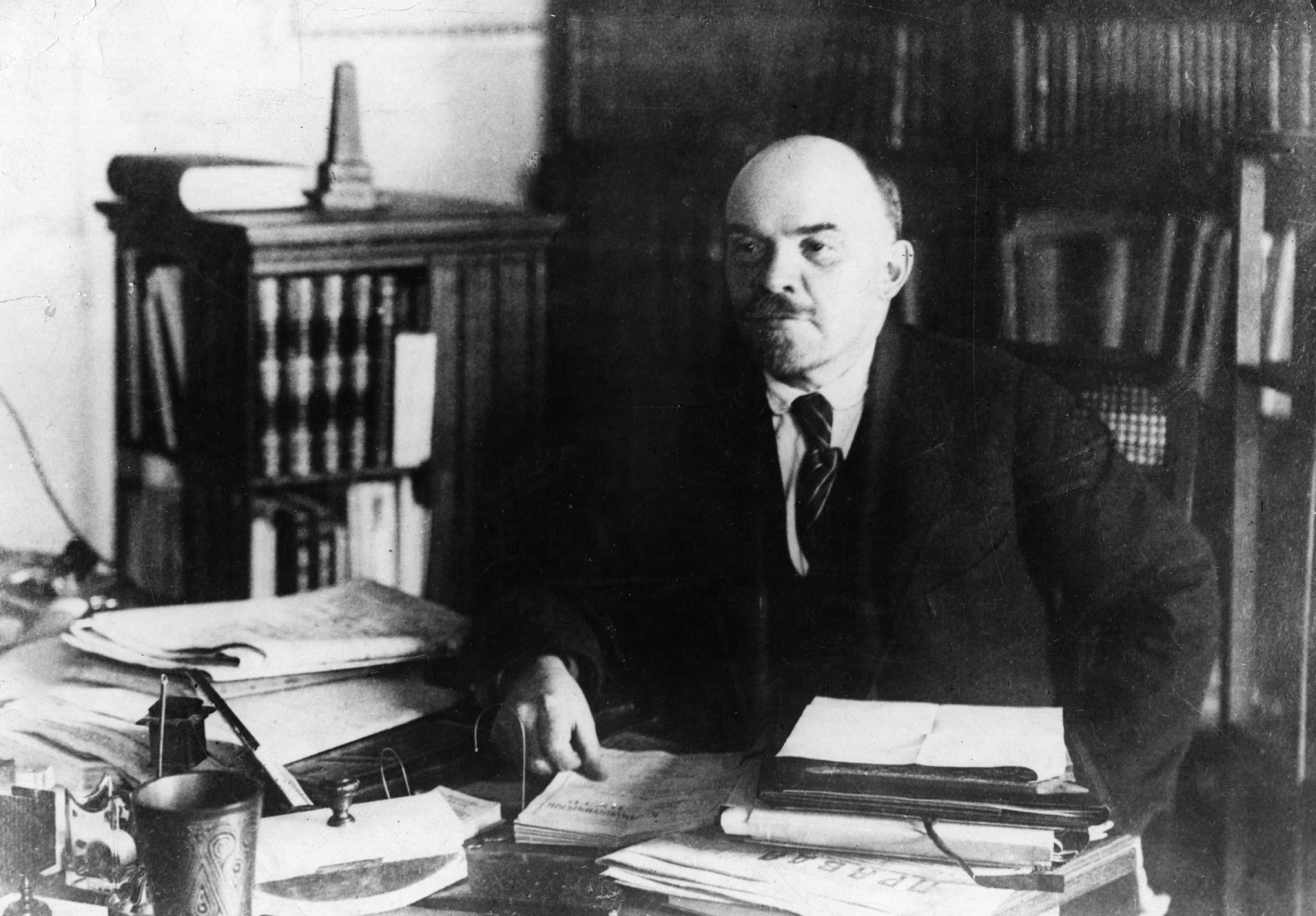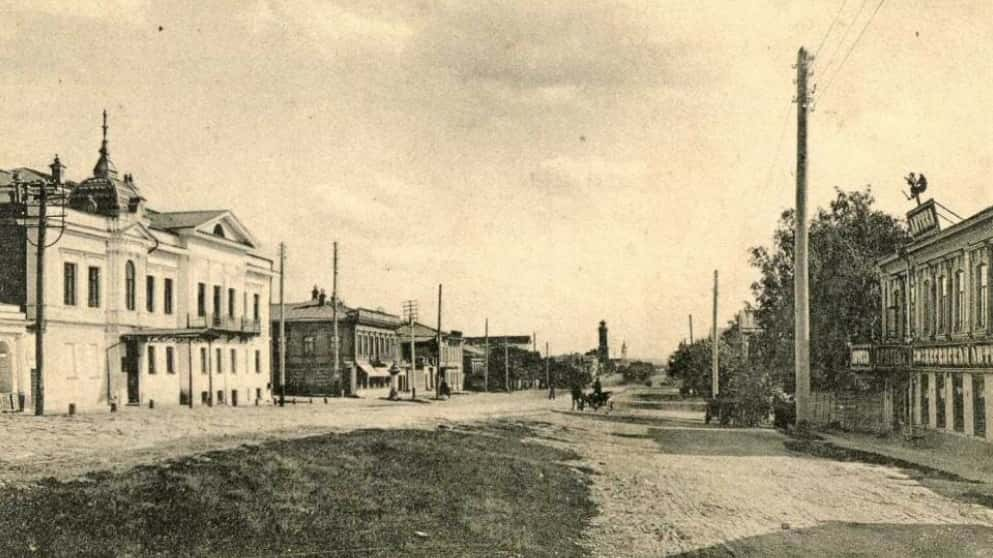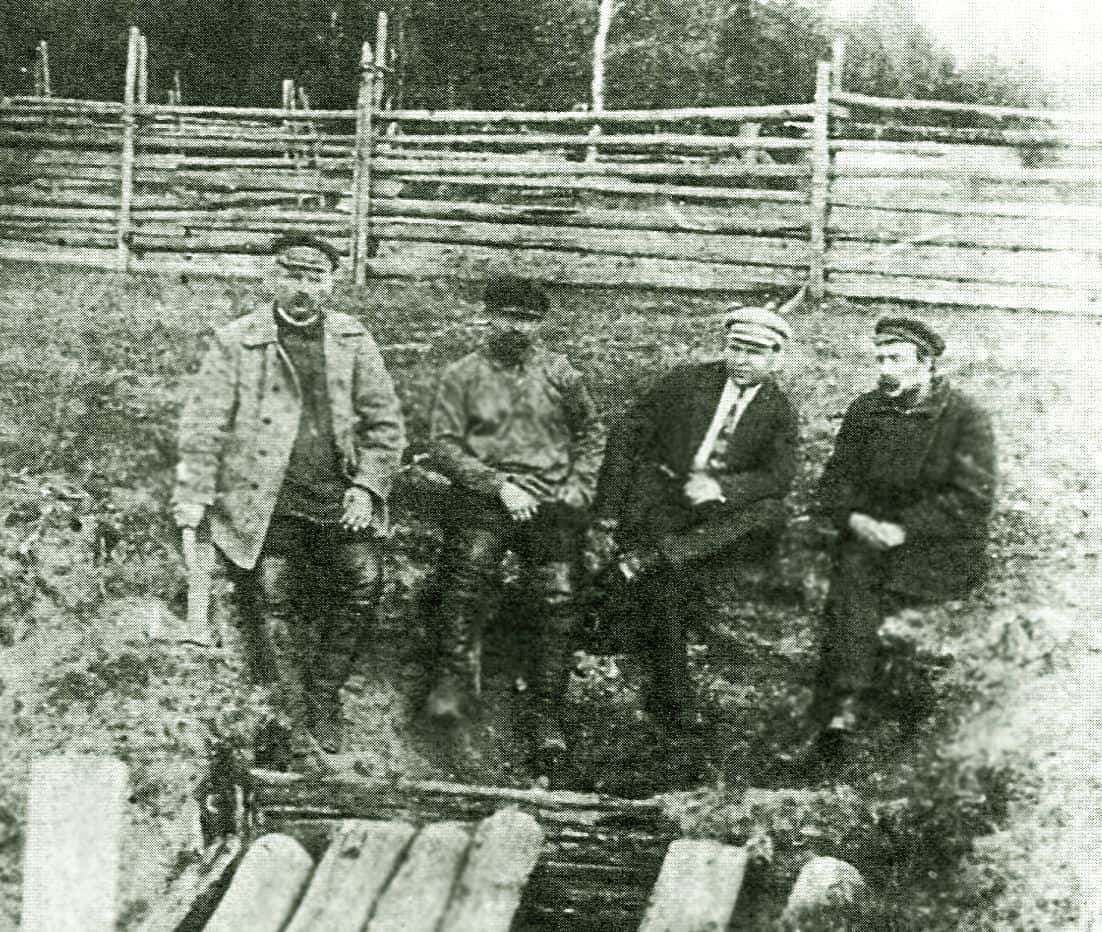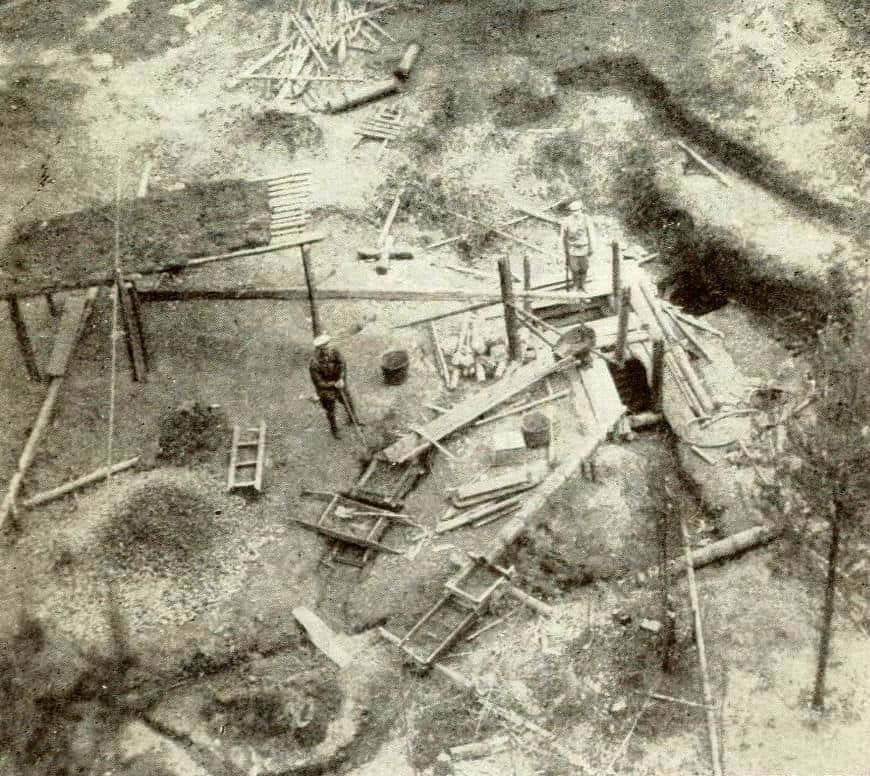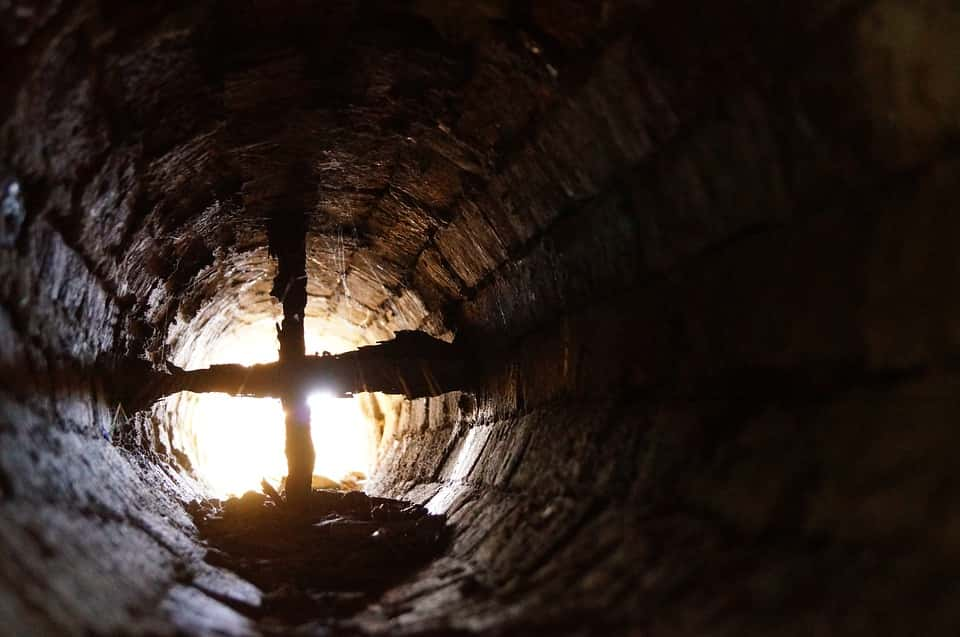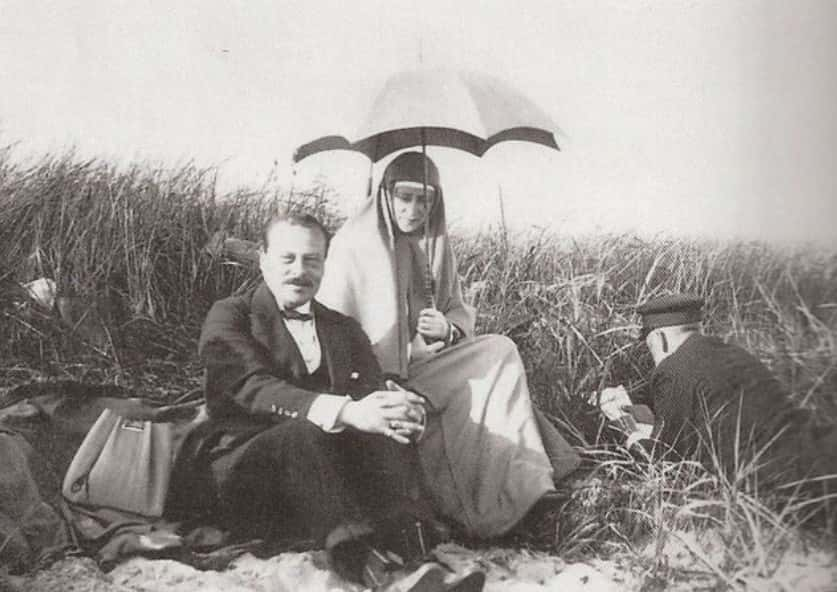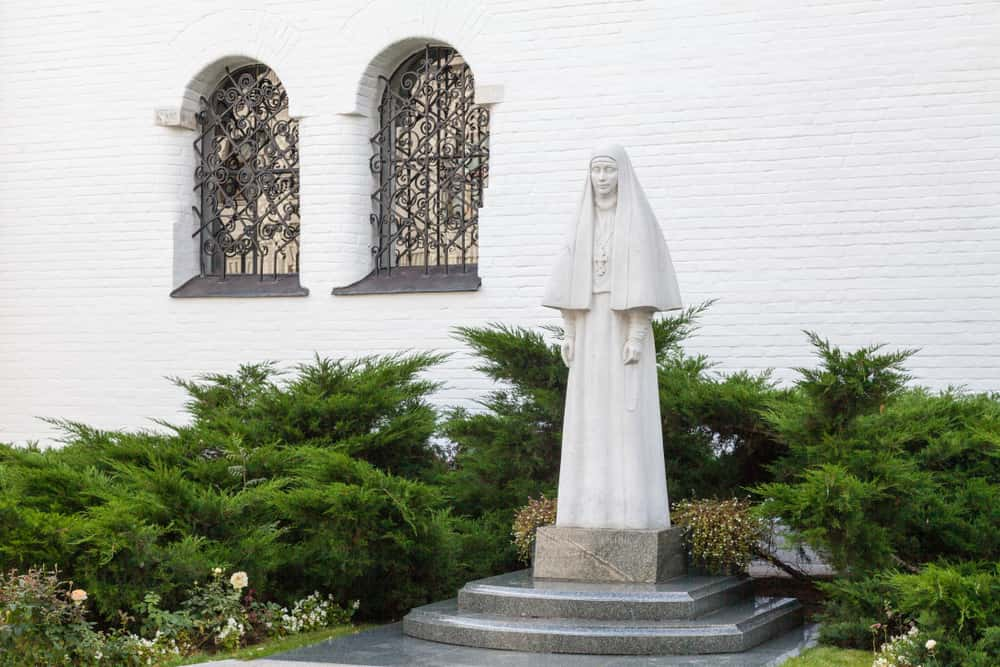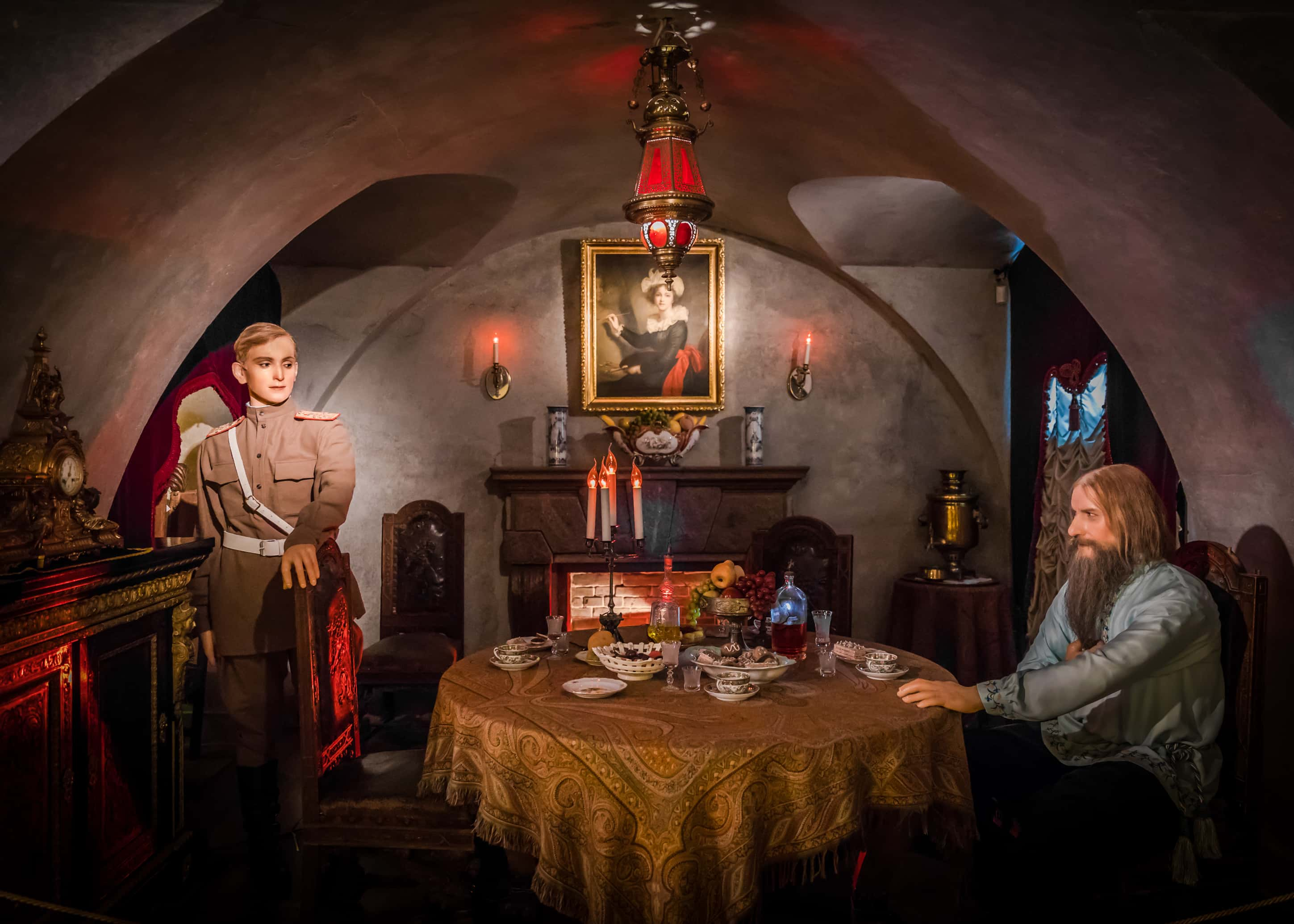17. She Angered Her Admirers
Although it wasn’t a requirement, Elizabeth Feodorovna converted from Lutheranism to Russian Orthodoxy in 1891. The move cemented her in the hearts of the Russian people and those of her husband’s family, but boy, did it tick off some of her past admirers. Kaiser Wilhelm II, who once loved her deeply, criticized her conversion as a purely political move. True or not, there was no denying that the Grand Duchess did have a powerful presence in court.
18. She Played The Matchmaker
Elizabeth Feodorovna resisted being pressured into marriage, but she wasn’t above playing matchmaker herself! This was especially true when it came to the marriage between her younger sister, Alix, and Tsar Nicholas II of Russia—who happened to be Sergei’s nephew. Even as kids, Feodorovna’s younger sister and Nicholas II loved each other deeply.
To ensure her sister’s happiness, Elizabeth Feodorovna moved heaven and earth. As we’ll see, she didn’t quite know what she was getting her sister into…
19. She Encouraged Her Sister
To make the match work, Elizabeth Feodorovna needed to solve two major problems: her sister’s hesitancy to convert to Russian Orthodoxy, and her grandmother’s opposition towards the match. Elizabeth convinced her sister that conversion didn’t mean eschewing her beliefs, which calmed some of her younger sister’s fears and concerns. With that out of the way, Elizabeth just needed to find a way to deal with her grandmother.
20. She Succeeded… At A Cost
Feodorovna’s plan to deal with Queen Victoria turned out to be pretty ingenious. She simply ignored her, and convinced Sergei and Nicholas’s family to accept the match instead. Eventually, a mix of Elizabeth’s cajoling and the ailing health of Nicholas II’s father forced the Russian royal family to approve of Alix and Nicholas’s marriage.
The Princess was ecstatic, but in a dark twist, her grandmother had good reason to oppose the marriage.

History's most fascinating stories and darkest secrets, delivered to your inbox daily.
21. Her Grandmother Was Right
Her grandmother’s main concern was over Russia’s political instability and policies, and it came back to haunt Elizabeth Feodorovna in a big way. In 1891, the reigning tsar appointed Feodorovna’s husband as the governor-general of Moscow, disrupting their quiet life in St. Petersburg. This was already bad enough, but it was small potatoes compared to what Elizabeth Feodorovna’s husband did next.
22. Her Husband Committed Heinous Acts
Elizabeth Feodorovna’s husband began his tenure as governor-general by expelling Moscow’s 20,000 Jewish citizens. He believed that this move was necessary for a strong, nationalist government, and so, he began kicking people out of the city over the course of 12 months. Although some managed to leave voluntarily, many were unwilling, or unprepared, to leave their homes behind. All Elizabeth could do was watch the proceedings in abject horror.
23. The Atrocities Sickened Her
Elizabeth Feodorovna stood witness as officials forcibly expelled the unmarried and childless from Moscow. Next went apprentices and families with up to four children. Finally, officials forced old Jewish settlers, some who lived in Moscow for the past 40 years, to leave their homes. After seeing whole families leave in little more than rags due to her husband’s actions, Elizabeth made an ominous and prophetic declaration to her husband.
24. She Predicted Their Downfall
As her husband’s men expelled the last of the Jews from Moscow—and forced any remaining young Jewish women to register as prostitutes—Elizabeth made a chilling prediction. She told her husband that “God will punish us severely.” Elizabeth had no idea when divine punishment would arrive, but she believed it would eventually.
Of course, she was correct; over the years, tragedies large and small hounded both her and her husband.
25. She Protected Her Husband
The first of these tragedies came in the form of vicious rumors regarding Elizabeth’s marriage with her husband. Many interpreted her husband’s emotional distance as arrogance, just as she once had; while this was untrue, it greatly damaged her husband’s reputation. Many speculated that her husband’s coolness extended to the bedroom, and these suspicions weren’t completely groundless.
26. She Never Had Children
Whether by choice or due to medical complications, Elizabeth Feodorovna and her husband remained childless for their entire lives. Her lack of children and her husband’s less-than-stellar reputation left the poor princess defending both her marriage and her husband from malicious gossip from all corners of the country. And that wasn’t the only issue troubling Elizabeth.
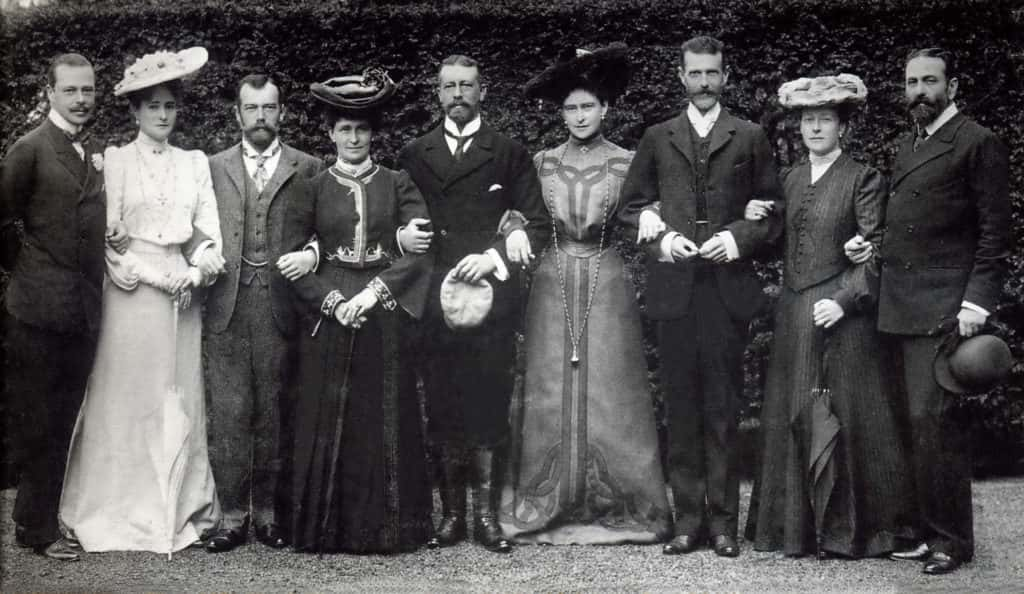 Romanov Empire
Romanov Empire

History's most fascinating stories and darkest secrets, delivered to your inbox daily.
27. She Loved Her Family
In 1902, the royal family banished Grand Duke Paul from Russia due to his marriage to a woman of lower rank. As a result, Elizabeth and Sergei asked for, and received, guardianship over Paul’s children, Maria and Dimitri. This should have been the perfect arrangement; both Elizabeth and her husband loved the children, and had their best interests at heart. Under the surface, however, things were definitely less-than-perfect.
28. Her Children Hated Her
Elizabeth’s husband worried over the education and upbringing of Maria and Dimitri, to the point of obsessiveness. His overbearing nature really didn’t sit well with his newly adopted kids, but it gets worse. Maria and Dimitri blamed both Elizabeth and Sergei for separating them from their real father. The household situation was bad enough, but karma had more in store for poor Princess Elizabeth.
29. She Sensed Incoming Danger
On January 1, 1901, Elizabeth’s husband Sergei resigned amid growing political discord within the country. Shortly after, Elizabeth, along with her husband and foster children, moved to the Nicholas Palace to remain in relative safety. She rarely went outside for fear of attempts on her life. The isolation was difficult, but a necessary measure to keep the family away from harm. Unfortunately, it wasn’t enough to save them all.
30. She Lost Her Husband
On a cold, winter day on February 17, 1905, Elizabeth’s worst nightmare came true. A revolutionary named Ivan Kalyayev took the life of Elizabeth’s beloved husband Sergei by blowing up his carriage. The aftermath of the explosion was absolutely horrific—it completely mutilated her husband’s body, and scattered his remains across the snow. Upon hearing of the explosion, Elizabeth rushed to the grisly scene, and her reaction was totally unexpected.
31. She Stood Tall Under Pressure
No one would have blamed Elizabeth for passing out at the sight of her husband’s remains, but she defied all expectations by remaining calm, if rather shocked. After authorities captured Kalyayev, Elizabeth helped gather up her husband’s remains—which included gathering his fingers, still adorned with rings, off the roof of a building. With that stomach-turning act completed, she returned home…And her calm façade crumbled.
32. She Showed Weakness
Upon returning home, Elizabeth’s reaction was chilling. She went into her rooms, with no one but her foster daughter Maria at her side. For a long time, Elizabeth refused to cry, only staring vacantly out into space as visitors came and went. Eventually, her self-control began to crumble, and she broke down into heart-wrenching sobs.
Her friends and family feared that Elizabeth, for the first time, might just have a complete mental breakdown.

History's most fascinating stories and darkest secrets, delivered to your inbox daily.
33. She Surprised Her Loved Ones
Instead of having a breakdown, Elizabeth Feodorovna did something that was quite the opposite of what her friends and family expected. For days leading up to her husband’s burial, Elizabeth remained in constant prayer. No one had any idea what she prayed for, and the deeply religious Princess remained quiet on the matter. Then, Elizabeth suddenly demanded to see Kalyayev, and the contents of her prayer suddenly became clear.
34. She Forgave Him
When the authorities brought Elizabeth Feodorovna before her husband’s assassin, Ivan Kalyayev, she asked only one question. She demanded to know why he took her husband’s life. In response, Kalyayev told her that he “was taking revenge for the people.” And, instead of getting angry, Elizabeth did the one thing no one could’ve anticipated.
She told Kalyayev that she forgave him. She begged him to repent, and to stop the cycle of revenge right there. Unfortunately, her request fell on deaf ears.
35. He Rejected Her
Ivan Kalyayev staunchly refused to repent, determined to become a martyr for the Revolution. As such, authorities sentenced the killer of Elizabeth Feodorovna’s husband to hang on May 23, 1905. Karma took everything from Princess Elizabeth in one blow: it took her husband, her happiness, and her chance to save the soul of Kalyayev. After this, Elizabeth changed, and became someone almost entirely different.
36. She Completely Transformed
Four years after her husband’s passing, Elizabeth Feodorovna made a drastic lifestyle change. She sold off her entire collection of jewels (which included her wedding ring) and other luxuries in her possession. With the money from the sale, Elizabeth opened the Convent of Saints Martha and Mary, and became the convent’s abbess. If she couldn’t make her people’s lives better as a Princess, she was going to do it as a nun.
37. She Devoted Herself To The Destitute
Elizabeth Feodorovna hoped to begin a religious community within the convent made up of women from all levels of society. Together, she and her nuns would meet the needs of the poor, and for the most part, Elizabeth did a dang good job. She opened a hospital, chapel, pharmacy, and orphanage on the grounds, and at its peak, fed 300 meals per day to the poor. Unfortunately, being a nun didn’t let her escape the drama of the royal family.
38. She Worried Over Her Family
Elizabeth Feodorovna may not officially be a part of the royal family anymore, but she didn’t worry about them any less. In particular, she worried over the brewing anger directed at the Russian Imperial family and her younger sister, Alix, now the empress consort. The people were not happy with her sister’s sporadic behavior at court, and only grew angrier by the day.
Fearing her sister’s downfall, Elizabeth inserted herself into royal life one more time.

History's most fascinating stories and darkest secrets, delivered to your inbox daily.
39. She Protected Her Sister
In 1916, Elizabeth Feodorovna met with her sister, determined to set her straight. The former princess pointed out that Alix now made all her political decisions based on the “advice” of Grigori Rasputin, a mystic and self-serving quack doctor. Elizabeth begged her younger sister to consider the consequences of trusting such a man, but her warnings were too little, too late.
40. Life Crashed Down Around Her
Elizabeth Feodorovna had to watch in horror as another one of her disturbing predictions came true. Just as she’d said, her sister’s Alix’s unpopular support of Rasputin, coupled with the economic decline of the country, sparked a revolution in 1917. Her younger sister’s husband abdicated the throne, putting all members of the Russian royal family—including the former royal, Elizabeth Feodorovna—in a precarious position.
For now, all Elizabeth could do was wait as events unfolded…And they didn’t go the way that she hoped.
41. They Came After Her
At first, the Provisional Government that took over did little more than keep the royal family under house arrest and attempt to expel them from the country. That all changed when the Bolsheviks took over. For the Bolsheviks, any trace of the royal family must be eliminated, and that included Elizabeth Feodorovna. In 1918, Vladimir Lenin called for her capture.
From there, everything for the ex-royal went downhill.
42. They Plotted Against Her
After her capture, Lenin moved Elizabeth Feodorovna to the city of Yekaterinburg. While there, familiar faces from the Russian royal family, along with the servants closest to them, joined her. With so many royals in one place, this would’ve been a prestigious gathering on any other occasion. This time, however, there was only unease, and the feeling for Elizabeth must have only increased when the men moved them to the outskirts of a small, quiet town.
43. They Took Her Away
Only July 17, 1918, just under a month after Elizabeth Feodorovna and the other royals entered the quiet town of Alapayevsk, chaos erupted. A few Bolshevik workers and a member of the Cheka entered the school where Elizabeth and the other prisoners were being held. Elizabeth and the others had all their money taken. Helpless, she could only await her fate.
44. They Took Her Into The Night
In the middle of the night, the Cheka roughly woke Elizabeth Feodorovna and the other prisoners, and forced them into carts. The drivers took Elizabeth and the rest of the group up a road, before stopping at an abandoned iron mine with a pit 66 feet deep. Suddenly, the drivers dragged Elizabeth and the others off the carts, and beat them into submission. After, they hauled Elizabeth towards the edge of the pit…And hurled her into the darkness.

History's most fascinating stories and darkest secrets, delivered to your inbox daily.
45. The Pit Swallowed Her Whole
Elizabeth Feodorovna fell for what must have seemed like forever, before landing with a bone-crunching thump at the bottom of the pit. She survived the initial fall, but that was just the start of her nightmare. Very quickly, the bodies of her fellow prisoners followed after her. After the Cheka threw everyone into the pit, they tossed in a hand grenade to finish the job.
They were sure it would work—but Elizabeth refused to give up.
46. She Never Gave Up
Whether by divine intervention, sheer determination, or dumb luck, only one prisoner fell victim to the grenade. Elizabeth Feodorovna, along with some of the other prisoners, still lived. In full defiance of her captors, Elizabeth began singing an Orthodox hymn from within the darkness of the pit. Soon, the voices of the other survivors joined her.
The Cheka, completely unnerved, threw another hand grenade in…And once again, Elizabeth refused to give up.
47. She Was Kind To The Very End
Elizabeth Feodorovna’s singing continued. As her voice floated up from within the iron mine, the Cheka threw large bundles of brushwood over the pit, set it alight, and left Elizabeth and the other victims to their fate. And still, this didn’t manage to end Elizabeth’s life. Instead, she eventually succumbed to her wounds from the fall, but not before tending to the injuries of another person in the shaft with her.
48. They Found Her
On October 8, 1818, the White Army discovered the iron mine that contained the bodies of Elizabeth Feodorovna and the other victims in her group. Most, like Elizabeth, succumbed to their wounds from the fall, or else slowly starved. They transferred the bodies to the Russian Orthodox Mission in Beijing, China. Later, in 1921, Elizabeth’s body left for the holy city of Jerusalem, beginning an entirely different journey.
49. They Recognized Her
In 1992, the Moscow Patriarchate canonized Grand Duchess Elizabeth Feodorovna as Holy Martyr Elizabeth Feodorovna, bringing light to her work to uplift the poor and create a safe haven for women. Ironically, a statue of her was also raised in the garden of her convent after the Soviet Union dissolved, with an inscription that reads, “To the Grand Duchess Elizabeth Feodorovna: With Repentance.”
50. Speculation Surrounds Her Life
As with any member of the Russian Imperial household, gossip surrounds Elizabeth Feodorovna’s life. In 2010, a historian claimed that Elizabeth may have known that Rasputin was about to meet his untimely end. Before Rasputin’s killers even got a chance to take him out, Elizabeth allegedly sent out telegrams with details that revealed their identity. However, she declined to stop them because ending Rasputin’s life was a “patriotic act.”

